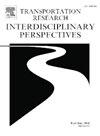Mapping and quantifying near-miss events involving vehicles and vulnerable road users in Reno and Sparks, Nevada
IF 3.9
Q2 TRANSPORTATION
Transportation Research Interdisciplinary Perspectives
Pub Date : 2025-07-01
DOI:10.1016/j.trip.2025.101514
引用次数: 0
Abstract
Rising injury and fatality rates of vulnerable road users (VRUs) challenge policy efforts to make roads safer and contribute to public hesitancy to bike or walk more. To date, data-driven solutions to address VRU safety often rely on official crash data, but these data are limited in reflecting total safety experiences of VRUs. Near-miss events, which occur when a crash involving a vehicle and a VRU is narrowly averted, also contribute to hesitancy to bike or walk, but comparatively little is known about their location and frequency relative to official crashes. To address this, we distributed a web-based survey to bicyclists and pedestrians in Reno and Sparks, Nevada, USA. Analysis of their survey responses reveals that most traveled as a VRU frequently and had concerns about infrastructure and their safety. Using an interactive map, 175 respondents identified 277 locations where they either previously experienced a near-miss or felt unsafe with traveling as a VRU. We deployed mobile roadside LiDAR sensors to continuously collect data over two 72-hour periods in October 2023 at the 10 most frequently identified intersections in the survey responses. We recorded 251 near-miss events between vehicles and either bicyclists or pedestrians using LiDAR trajectory data and the post-encroachment time (PET) near-miss detection method. Our results underscore the prevalence of near-misses, as only 26 official crashes were recorded at these same intersections over the previous five years. The observed high relative frequency of near-miss events underscores the importance of integrating near-miss events into countermeasure planning.
绘制和量化内华达州里诺和斯帕克斯涉及车辆和脆弱道路使用者的未遂事件
弱势道路使用者的伤害和死亡率不断上升,对提高道路安全性的政策努力构成挑战,并导致公众对更多地骑自行车或步行犹豫不决。迄今为止,解决VRU安全问题的数据驱动解决方案通常依赖于官方碰撞数据,但这些数据在反映VRU整体安全经验方面受到限制。当车辆和VRU险些相撞时,就会发生未遂事故,这也会导致人们对骑自行车或步行犹豫不决,但相对于官方撞车事故,人们对其位置和频率知之甚少。为了解决这个问题,我们向美国内华达州里诺和斯帕克斯的骑自行车者和行人分发了一份基于网络的调查。对他们的调查回应的分析显示,大多数人经常作为VRU旅行,并且对基础设施及其安全感到担忧。通过使用交互式地图,175名受访者确定了277个地点,这些地点要么是他们之前作为VRU旅行时经历过的险情,要么是他们感到不安全的地方。我们部署了移动路边激光雷达传感器,在2023年10月的两个72小时内,在调查回复中最常识别的10个十字路口连续收集数据。我们使用激光雷达轨迹数据和侵犯后时间(PET)近距离检测方法记录了251起车辆与自行车或行人之间的近距离碰撞事件。我们的研究结果强调了未遂事故的普遍性,因为在过去的五年里,在这些路口只记录了26起官方撞车事故。观察到的高相对频率的近靶事件强调了将近靶事件纳入对策规划的重要性。
本文章由计算机程序翻译,如有差异,请以英文原文为准。
求助全文
约1分钟内获得全文
求助全文
来源期刊

Transportation Research Interdisciplinary Perspectives
Engineering-Automotive Engineering
CiteScore
12.90
自引率
0.00%
发文量
185
审稿时长
22 weeks
 求助内容:
求助内容: 应助结果提醒方式:
应助结果提醒方式:


